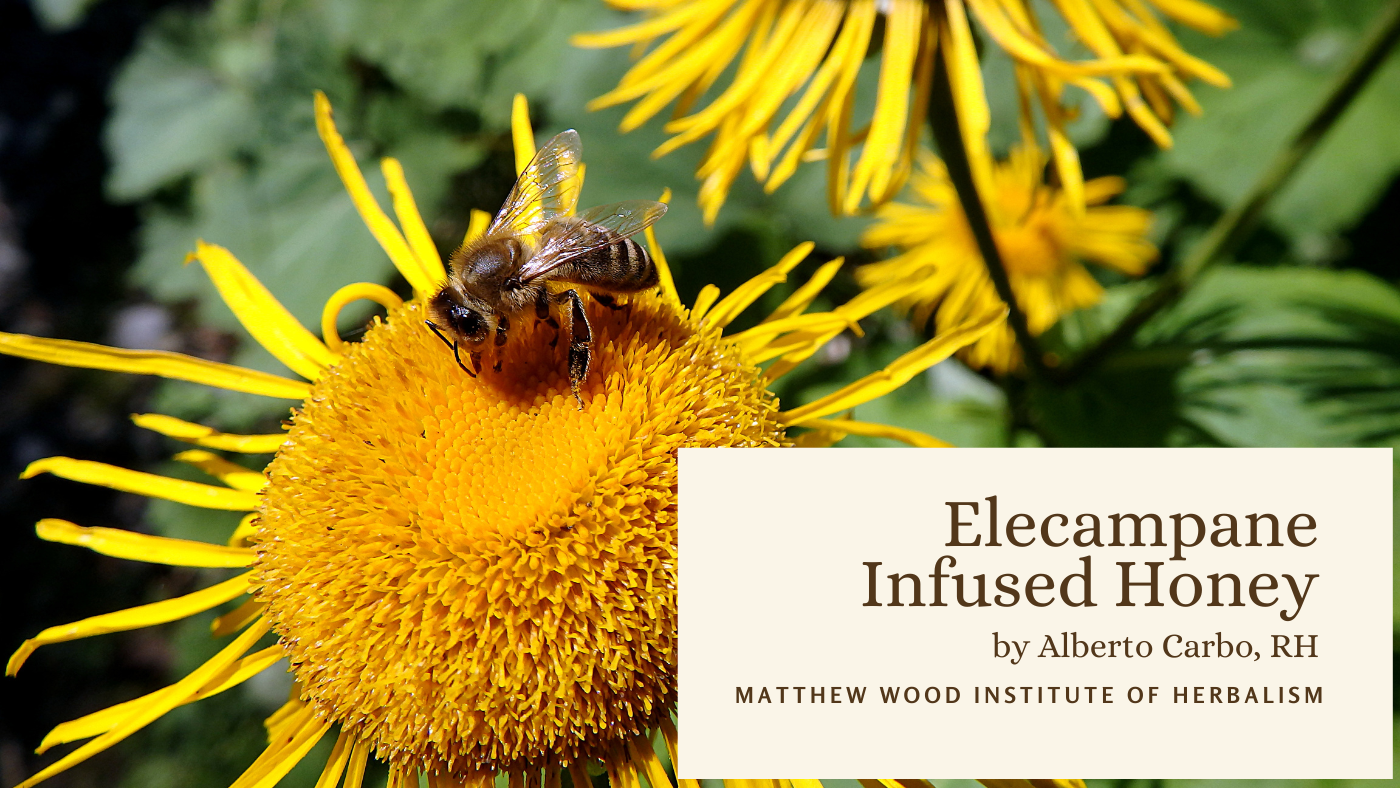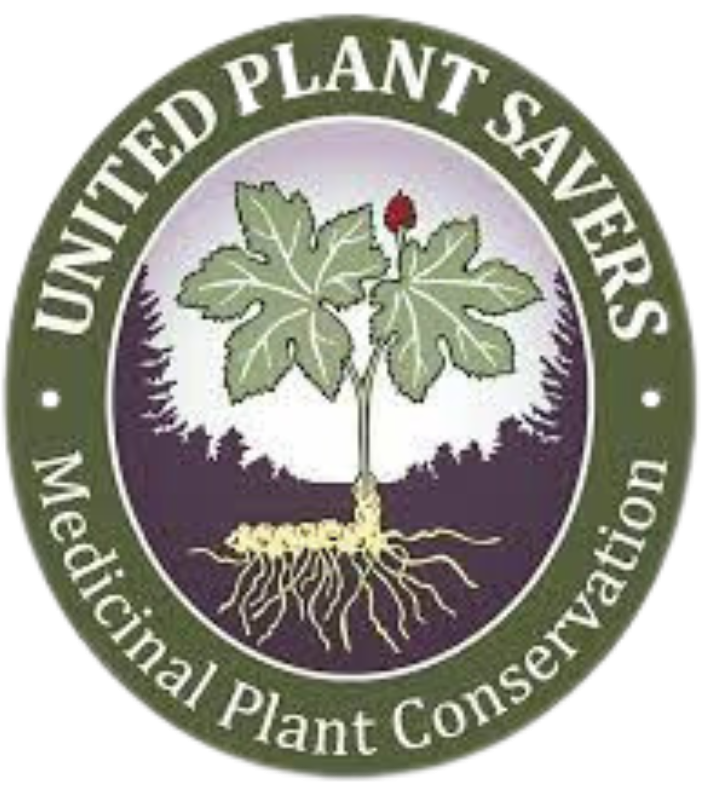Jump to Recipe
Mythical Medicine, Tissue States & Elecampane Infused Honey
As the warmth and light of summer begin to fade into the distance, we are once again gently and gradually reminded that colder temperatures and reduced light are on the way. Historically, our ancestors would use this time to harvest, prepare, and store what they could to carry them through the coldest and darkest times of the year.
As the warmth and light of summer begin to fade into the distance, we are once again gently and gradually reminded that colder temperatures and reduced light are on the way. Historically, our ancestors would use this time to harvest, prepare, and store what they could to carry them through the coldest and darkest times of the year.
With sun-like flowers, bright, yellow, and vibrant, Elecampane gives us the opportunity to experience the warmth and vibrancy of summer sunshine when its abundance wanes.
From its name alone, Elecampane, we understand that at least as far back as ancient Greece, it’s sun-like qualities were also known. Enula campana is the historical botanical name of Elecampane, as referred to by Pliny the Elder, Dioscorides, and Theophrastus, and later by Galen, and other Roman writers.
Enula comes to us from the Greek helenion, which is thought to be derived from the name Heléne, or Helen, in reference to Helen of Troy. Helenion would be understood today as ‘Helen’s plant’. In poetic prose, classical authors such as Homer, Apollodorus, Euripides, and others, tell a timeless tale of passion, beauty, tragedy, and melancholy that outlines morals consequential to the human experience while simultaneously conveying the mental, emotional, and physical characteristics for which Elecampane is medicinal.
The ancient Greek name Heléne literally means “torch”, “ray”, “light” or “sunbeam” and is derived from the root word helios, meaning the Sun. In other words, the ancient Greeks literally named Elecampane “sunshine”.
Like many Asteraceae family members, Elecampane’s flowers resemble a shining sun, but in addition to visual characteristics, the taste of Elecampane’s root can help us understand that her name was intentionally chosen in order to inform us of her medicine.
At first taste, intensity may be the only descriptor that comes to mind, but with close attention, we’ll notice that there are a few layers to Elecampane’s taste.
- We first experience the pungent taste that immediately stimulates our nerves with excitement and warmth. Slight tingles dissipate and travel throughout, bringing warmth and stimulation to needed areas.
- The bitter taste follows, stimulating the vagus nerve directly, subsequently encouraging gastric secretions, and a transition to a parasympathetic state.
- Acrid comes last, with a sharp biting sensation that almost makes you shiver. Acridity stimulates secretions and helps to clear stagnation or congestion.
Like sunshine, Elecampane warms and stimulates the organism. This can make a world of difference during the cold, dark winter, during which we experience a slowing down of our metabolism and are most susceptible to slowed digestion, congestion, stagnant respiratory conditions, and a dampened mood. Just like the ultraviolet rays of the sun, Elecampane also lives up to her name with her anti-viral phytochemicals.
One of my favourite recipes, Elecampane-infused honey, captures the sun-like qualities of this aromatic root. This simple and practical folk medicine is easy to prepare, versatile, and supports well-being in multiple ways.
If you want to get right to the recipe, skip down below, but if you’re curious about Helen of Troy, and how her story (in a nutshell) educates us on the full breadth of Elecampane’s medicine, keep reading!
Helen, daughter of Zeus (god) and Leda (mortal), is said to have been the most beautiful woman on Earth – in itself, a reference to Helios, the ‘shining one’, the ‘brightest one’. She was the princess of Sparta and, inevitably, had many suitors seeking her hand in marriage.
Understanding her unparalleled beauty, Helen’s stepfather, King Tyndareus of Sparta, wisely insisted that all of Helen’s Greek suitors swear an oath: that they would accept and respect whomever Helen chose to marry. Helen chose Menelaus, the prince and future King of Sparta.
Paris, the Prince of Troy, lusted for Helen and wished to make her his. With Aphrodite’s help, Paris abducted Helen and brought her back to Troy. Outraged, Menelaus rallied the Spartans and the Greeks, vowing to retrieve his beautiful wife, and thus began the famous Trojan War.
It is said that as she was brought from Sparta to Troy, Helen wept and wept. From every single tear that fell to the ground, an Elecampane plant grew. Germinated out of Helen’s deep grief, Elecampane was known since then as an applicable remedy for grief, especially when instigated by feeling out of place, like one does not belong, or being torn away from home.
In folk traditions around the world, emotional connection is associated with the chest area, and more specifically with the lungs. In Traditional Chinese Medicine (TCM), the lungs are directly associated with grief, and it is understood that when grief is prolonged or unprocessed, it can result in weakened lung Qi (life force). In Ayurveda, the lung area is associated with prana (life force), and can be affected by emotional trauma.
From a Western Herbalism perspective, we can certainly see the association with grief and the lungs – have you noticed how much breathing is affected when someone is crying? Or think about how people express ‘tightness in the chest’ when they are processing heavy emotions, or working through grief.
If we think about the Tissue States, grief would fall under the category of the Depressed tissue state. When we are in grief, that tightness in our chest indicates a lack of vitality due to constriction, and constriction inevitably leads to reduced blood and lymph flow, and eventually a system that is malnourished, cold, and depressed, i.e lacking/lagging in function.
If the issue persists, the Depressed tissue state leads to Stagnation. If left unchecked, it will progress, leading towards compromised form and function of the organ or tissues, also known as the Atrophic tissue state.
While most people understand that proper lung function is paramount to survival, many do not realize that, aside from breathing, the lungs are also continually assisting in the elimination of gases, moisture, mucus, immune debris, and inhaled particles. The lungs are as much a system of elimination as other excretory organs such as the kidneys, liver, skin, and bowels.
Whether from grief or otherwise, if our lungs are depressed in function, expectoration and elimination of substances becomes difficult, and they’ll increasingly become susceptible to pathogens and inflammatory conditions. Elecampane can support lung health by warming, stimulating vitality, and encouraging healthy elimination from the lower respiratory system upwards.
Like all who gazed upon Helen’s beauty, or like all who walk under the warmth of the sun, Elecampane shares her warmth and stimulation with us, from the core outwards. As with the lungs, Elecampane also helps to stoke the fire of the belly, encouraging gastric secretions, thorough and timely digestion, optimised assimilation of nutrients, and proper elimination. As with the lungs, a depressed tissue state in the digestive tract compromises proper functioning that eventually leads to further complications.
Today, we understand that grief is not simply an emotional response, but a physiological one. When we experience grief, our body categorizes it as stress, shifting us into a sympathetic fight or flight state. Adrenaline and noradrenaline elevate, increasing heart rate and rapid, shallow breathing. From this perspective, we can understand how profoundly the mythical Helen of Campana tells us about the medicine of Elecampane.
At times, and especially when prolonged, grief can activate an unhealthy parasympathetic response – the ‘freeze’ response. This is a dorsal vagal parasympathetic response, and the person would exhibit signs of being numb, limp, or shut down. From a Tissue State perspective, this could be compared to the Atrophic tissue state – when the tissues have been Depressed for so long, they no longer function.
It is said that the Trojan War was 10 years long. It is not difficult to imagine that Helene could have eventually entered a dorsal vagal parasympathetic stress response – the ‘freeze’ state. Like any captive, one could imagine Helen would not only be depressed emotionally, but also physically and perhaps even Atrophic in certain physiological functions.
Helen of Troy provides us with a fitting archetype for the medicinal use of Elecampane, and a fantastic example of how savvy ancient cultures were able to weave medicinal lessons into mythological tales. It makes sense that long ago, before the written word was commonplace, the people of the land would have recorded medicinal knowledge in story and tale.
In more recent history, Carl Linnaeus dubbed Elecampane with the botanical binomial Inula helenium in 1753. In 1804, German pharmacist and chemist Valentin Rose was the first to isolate inulin from the Elecampane root. He named this new discovery in honour of the plant from which it came, and dubbed it ‘inulin’.
In so many cases, modern science corroborates what the ancients knew about plant medicine. Inulin was one of the first ever identified plant polysaccharides, and today we understand that Inulin is a prebiotic starch, beneficial for healthy gut bacteria. This means that Elecampane not only helps to warm, stimulate, and remove accumulations of phlegm and mucus due to stagnation in the digestive tract, it also simultaneously provides polysaccharides that help to rebuild and rebalance the health and vitality of the microbiome.
Now that we are familiar with the Elecampane archetype, let’s get back to our infused honey!
While there are many ways to prepare and preserve Elecampane, a honey infusion is one of my favorites, due to its ease of preparation and versatility in application. While Elecampane has a taste that many in our modern age would cringe at, the sweetness of the honey helps to assuage the weary taster and help the medicine down.
Once infused, your Elecampane honey makes a great complement to any herbal tea, and combines great with ginger, cinnamon, lemon balm, chamomile, holy basil, chai, coffee, warm water, and others. Spread it on your pancakes, toast, tea cookies, or crackers, or simply have a teaspoon on its own!
Use it when you are feeling sniffly, congested, or have a productive cough. It can also be used when experiencing indigestion, stomach cramps, or slow digestion.
Elecampane Infused Honey
**Permissions**
You’re welcome to share this blog post on social media and link back to it—please do! All images, photos, and written content are the creative property of the author and used with permission. If you’d like to reproduce or distribute any part of this content beyond social sharing, written permission is required.
**Disclaimer**
The information provided in this digital content is for educational purposes only and is not intended as medical advice, diagnosis, or treatment. It should not be used as a substitute for consultation with a qualified healthcare professional. Always consult a licensed healthcare provider before making any changes to your health regimen, especially if you are pregnant, nursing, taking medications, or have a diagnosed medical condition.
Matthew Wood, the Matthew Wood Institute of Herbalism, Earth to Stars Productions, and their employees, guests, affiliates, and collaborators assume no liability for the use or misuse of any information presented. The application of any material is solely the responsibility of the reader or participant.
Any descriptions of herbal or natural products, remedies, or techniques are for informational purposes only. These statements have not been evaluated by the Food and Drug Administration (FDA). This content is not intended to diagnose, treat, cure, or prevent any disease.
Participation in educational programs or use of this material does not confer certification, licensure, or professional qualification in herbal medicine or any healthcare field. Results or experiences described may vary and are not guaranteed.
This disclaimer shall be governed by and construed in accordance with the laws of Minnesota, USA, without regard to conflict of law principles.


